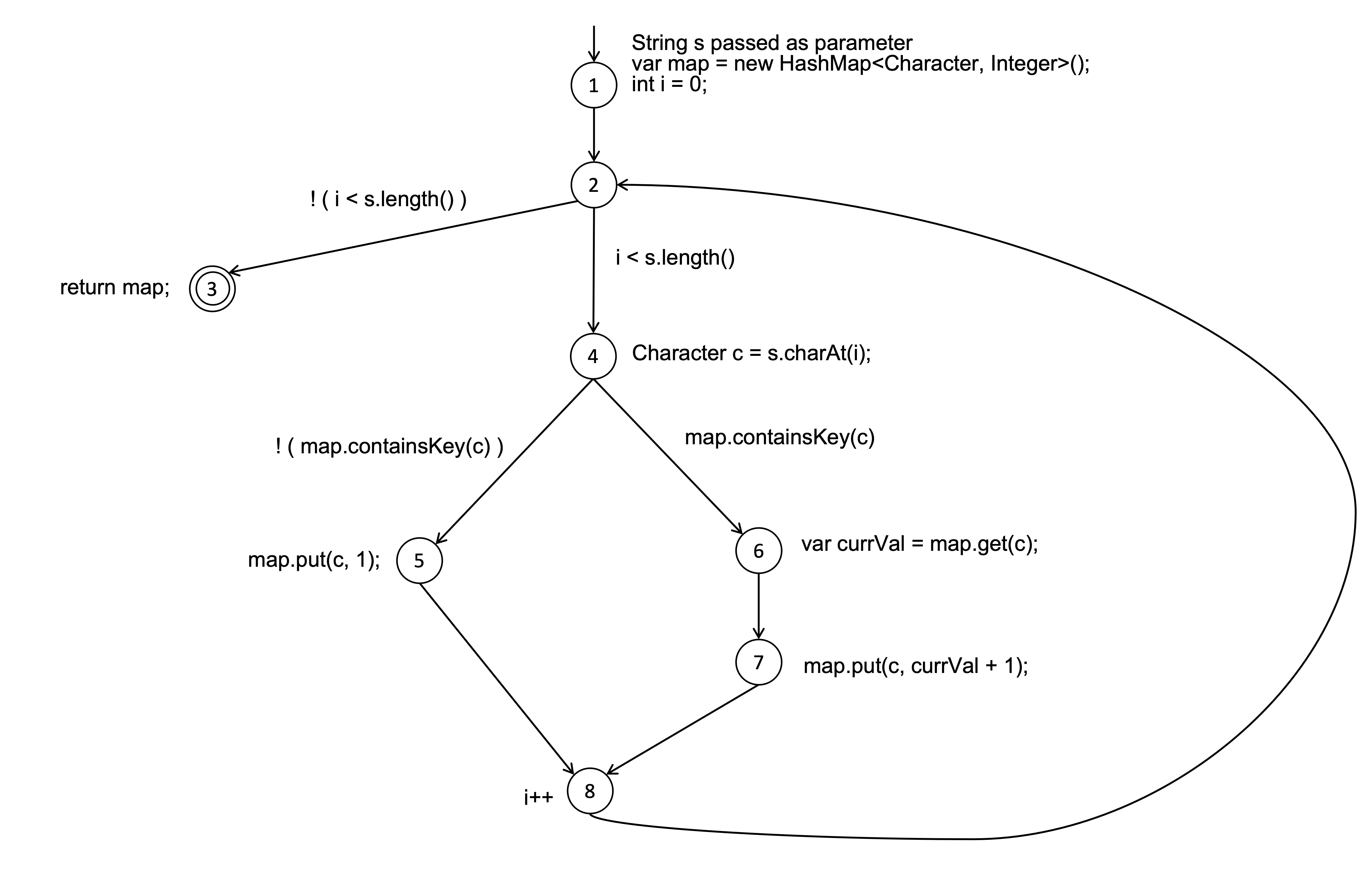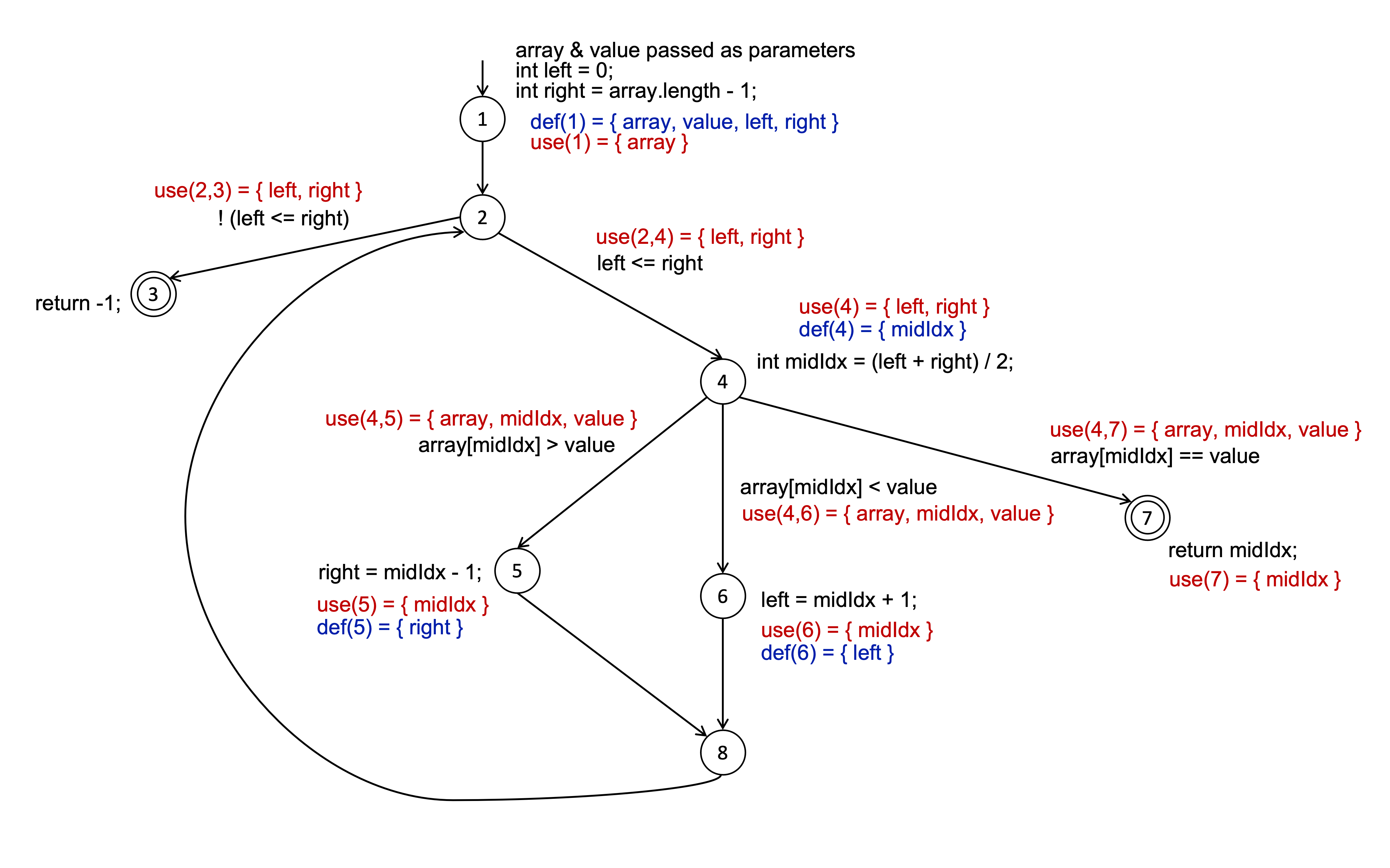Fall 2025 — Assignment 4
Due 27-October-2025, 11am EST (before class)Purpose:
- Understand graph-based testing and be able to apply graph coverage criteria to design tests
- Be able to analyze and determine the quality of the tests
- Practice test automation (using JUnit)
- Get ready for the final exam
All homeworks are due before class on the due date. All homework assignments must reflect your own understanding of the topic and be communicated in your own words. You may use one of the collaborative options. You may also request help and advice from your classmates on Piazza. Any help not allowed by that policy will be an honor violation.
Early-submission bonus points
Purpose: To encourage students to start working on the homework assignments early and recognize students who are actively engaged in the content
You will receive- 4% of the points you earn (from the assignment) if you submit your assignment at least 48 hours early (submitted by 25-October-2025 11am EST).
- 2% of the points you earn (from the assignment) if you submit your assignment at least 24 hours early (submitted after 25-October-2025 11am EST, by 26-October-2025 11am EST).
Note: The final submission timestamp shown on Gradescope will be used.
Part 1: [2 points] Drawing a graph
Consider the following Java method
/**
* Description: Leet Code 771
* You're given strings jewels (representing the types of stones that are jewels)
* and stones (representing the stones you have).
* Each character in stones is a type of stone you have.
* You want to know how many of the stones you have are also jewels.
* Letters are case sensitive, so "a" is a different type of stone from "A".
*
* numJewelsInStones("aAb", "dbaaAbbcd") returns 6
* since there are 2 "a" and 1 "A" and 3 "b" in the string.
*/
public static int numJewelsInStones(String jewels, String stones)
{
var jewelSet = new HashSet<Character>();
for (int i = 0; i < jewels.length(); i++)
{
jewelSet.add(jewels.charAt(i));
}
var count = 0;
for (int i = 0; i < stones.length(); i++)
{
if (jewelSet.contains(stones.charAt(i)))
count += 1;
}
return count;
}
Instructions:
(2 points) Draw a control flow graph (or graphs) representing the software under test. Annotate all line of code/code fragments. (no need for data-flow annotations).
- You may use any drawing software to draw your graph(s).
- Alternatively, you may draw your graph(s) by hand neatly and take a screenshot (if we cannot read your graph(s), we cannot assign points).
- Reminder: ensure that your graph is syntactically and semantically valid.
Part 2: [6 points] Structural-based coverage criterion
Consider the following Java method and the given graph (hw4.java)
/**
* This function parses a string s and returns a map containing the number
* of times each character occurred within the string.
*
* For example, if s = "testing"
* the frequencies method returns {s=1, t=2, e=1, g=1, i=1, n=1}
*/
public static Map<Character, Integer> frequencies(String s)
{
var map = new HashMap<Character, Integer>();
for (int i = 0; i < s.length(); i++)
{
Character c = s.charAt(i);
if (map.containsKey(c))
{
var currVal = map.get(c);
map.put(c, currVal + 1);
}
else
{
map.put(c, 1);
}
}
return map;
}

Instructions:
- (2 points) Given the above graph, design a set of test requirements which fulfills either
Edge coverage, Edge-pair coverage, or Prime path coverage.
- Clearly indicate in your write-up which criterion you selected.
- Discuss any infeasible requirements
- (2 points) Identify a set of test paths which fulfill your test requirements (from Part 2, question 1)
- (2 points)
Design a set of test cases for each test path (from Part 2, question 2)
- Reminder: A test case consists of input and expected output. Also include any relevant pre-state, post-state, or assumptions applicable to the problem.
- This will be one of two possible test sets you will implement in Part 5.
Part 3: [2 points] Data-flow annotations
Instructions:
(2 points) Annotate the graph from Part 2 with definitions and uses (i.e., data-flow annotations).
- You may either recreate the graph from scratch or simply add on top of the supplied graph (suggested)
Part 4: [6 points] Data-flow coverage criterion
Consider the following Java method and the given graph (hw4.java)
/**
* @param array an array in ascending order
* @param value the value to search for
* @return the index of 'value' in 'array' else -1
*/
public static int binarySearch(int[] array, int value)
{
int left = 0;
int right = array.length - 1;
while (left <= right)
{
int midIdx = (left + right) / 2;
if (array[midIdx] > value)
right = midIdx - 1;
else if (array[midIdx] < value)
left = midIdx + 1;
else
return midIdx;
}
return -1;
}

Instructions:
- (2 points) Given the above graph,
design a set of test requirements which fulfills either
All-Uses coverage or All-du-paths coverage.
- Clearly specify in your write-up which criterion you selected.
- Discuss any infeasible requirements
- (2 points) Identify a set of test paths which fulfill your test requirements (from Part 4, question 1)
- (2 points)
Design a set of test cases for each test path (from Part 4, question 2)
- Reminder: A test case consists of input and expected output. Also include any relevant pre-state, post-state, or assumptions applicable to the problem.
- This will be one of two possible test sets you will implement in Part 5.
Part 5: [4 points] Test Automation
- Decide which test set you will automate (a test set you designed in Part 2 or a test set you designed in Part 4, automate only one test set)
- Make comments in your JUnit test file (.java file)
- Clearly specify which test set you automate (test set from Part 2 or test set from Part 4)
- Reminder: a test set is a collection of test cases. For full credit, automate an entire set of test cases, not just some test cases.
- For each JUnit test method, clearly identify which test case(s) it is for
- For grading purposes, the grader(s) must be able to map between the JUnit test methods and the tests you designed.
- Clearly specify which test set you automate (test set from Part 2 or test set from Part 4)
- Demonstrate success by
- Submitting your JUnit tests (.java)
- A screen shot showing the result of execution (displaying the results of all tests).
- Embed the evidence showing the result in the your write-up.
- By default, we will download and run your JUnit test file against the program under test (the original version posted for this assignment). Thus, it is important that you do not modify the program under test (except the package's name).
- Grading for this part will be based on:
- The number of test cases (i.e., reflecting the test requirements) you automate
- The quality of your test code
- The quality of comments in your test file
- Note:
- (-4 points) If your submission does not include your JUnit test file (.java) or if your JUnit test file does not compile or does not run. Do not submit .class file(s).
- (-2 points) If your submission does not include the evidence demonstrating the result of execution; be sure that the evidence shows the results of all tests.
Do NOT modify the program under test.
Note that the Graph Coverage Web App and Data Flow Coverage Web App on the book web site will let you check (most of) your work. However, you should be able to apply the concept on a given software artifact without the tool.
Grading Rubric
[Total: 20 points] Complete the tasks. Provide correct and clear solutions. Properly document your solutions.
( -5 points) for 24 hours late (submitted after 27-October 11am EST, by 28-October 11am EST)
(-10 points) for 48 hours late (submitted after 28-October 11am EST, by 29-October 11am EST)
(-2 points) for submitting a Word document or handwriting, or a write-up that is not a typed PDF file.
Submission
Save your write-up as a PDF file (only typed PDF is acceptable) — No handwriting. No Word document. Only the graphs may be hand-drawn neatly.
Submit your JUnit test file(s), .java (not a .class).
Each team submits only one copy.
Upload your report as a PDF and your JUnit test file(s) (.java) to Assignment 4 on Gradescope. Make sure you connect your partner to your group on Gradescope so that everyone receives credit.
Making your submission available to instructor and course staff is your responsibility; if we cannot access or open your file, you will not get credit. Be sure to test access to your file before the due date.
Released under the
 CC-BY-NC-SA 4.0 license.
CC-BY-NC-SA 4.0 license.
Last updated 2025-10-07 9:02